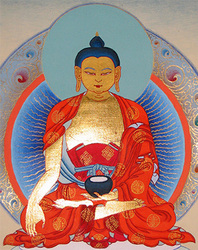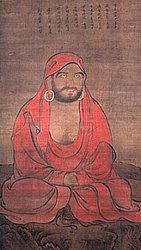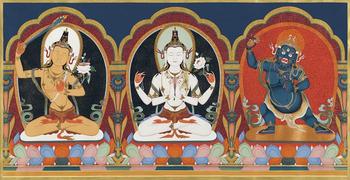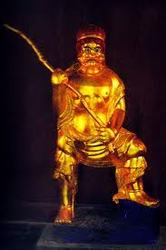What is Buddhism?
Overview
Buddhism is both a religion and a philosophy. Siddartha Gautama (aka the Buddha) was an awakened/enlightened teacher who shared his personal insights with others to help end ingonrance, cravings, and suffering on the path to attain Nirvana in order to stop the never ending cycle of rebirth.
The foundation of Buddhist tradition and practice are the Three Jewels: the Buddha, the Dharma (the teachings), and the Sangha (the community).Taking Refuge in the triple gem" has traditionally been a declaration and commitment to being on the Buddhist path and in general distinguishes a Buddhist from a non-Buddhist.
Other practices may include following Ethical Precepts, Supprting the Monastic Community, Renouncing conventional living and becoming a monastic/monk;
the development of mindfulness and the practice of meditation; cultivation of higher wisdom and discernment; study of scriptures; devotional practices; ceremonies; and in the Mahayana tradition, invocation of buddhas and bodhisattvas.
FOUNDER

Bodhidharma
Bodhidharma was a Buddhist Monk who lived during the 5th or 6th century and the 28th Patriarch of Buddhism in an uninterrupted line that extends all the way back to the Buddha himself. His teachings and practice centered on meditation and the Lankavatara Sutra. He is traditionally credited as the transmitter of Chan/Zen to China and is regarded as the 1st Chinese Patriarch.According to legend his is also credited with developing a special type of physical training that he taught the monks of the Shaolin Temple which in turn led to their famed martial arts skills. They describe Bodhidharma as being very disturbed by the poor physical shape of the monks. To remedy this he taught them 3 series of skill sets: 18 Lohan hands, Muscle Changing Cleansing and Bone Marrow Wash.
VAJRAPANI
Vajrapani (thuderbold/diamond in the hand) is one of the earliest bodhisattvas of Mahayanna Buddhism. He is the protector and guide of the Buddha and rose to symbolize the buddha’s power. Vajrapani was used extensively in Buddhist iconography as one of the 3 protective dieties surrounding the Buddha. Each of them symbolize one of the Buddha’s Virtues: - Avalokitsevara (compassion) Manjusri (wisdom), and Vajrapani (power). As such he is worshiped at the Shaolin Temple as their patron saint and protector. One story has Shaolin Monk Seng Chou praying to Vajrapani and was answered with supernatural strength and fighting abilities. Shaolin also views Vajrapani as the emanation of Bodhisattva Guan Yin. He is historically worhsipped as the creator/founder of shaolin’s famous staff fighting methods being known as Narayana. So much so that a Stele was erected depicting Vajrapani holding a Fighting Chinese Staff instead of his usual Vajra.
Jinnaluo Wang
The figure of Jinnaluo Wang (那罗殿) is associated with the Shaolin Temple. . The technique of Shaolin Stick appeared in the fourteenth century during the revolt of the Red Turbans (Hongjinjun,红巾军), which ended the Yuan Dynasty. This legend, the monastery was being attacked by insurgents. A kitchen fire monaco keeper, came armed with a rod and routed the rebels. Later, the Bonzi recognized that action in the action of the protective deity Jinnaluo Wang. Also according to (哈麻), School of Lamaist Jinnaluo, taught the handling of the stick and the Bonzo Shaolin boxing (匾囤). Today, inside the Shaolin Temple there is a pavilion dedicated to this deity and called Jinnaluo Dian (那 罗 殿). It is represented as a demon with big eyes and teeth feral, wielding a sledgehammer.


